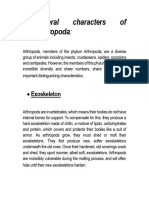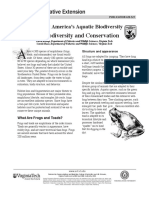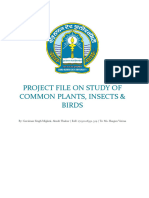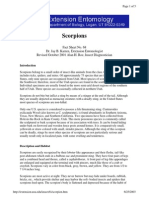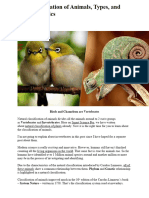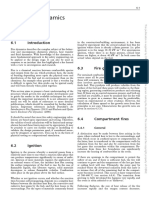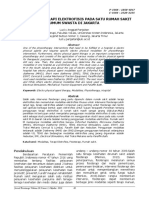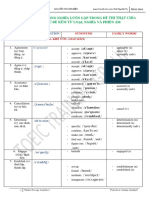centipede
centipede
Uploaded by
beatbot317mCopyright:
Available Formats
centipede
centipede
Uploaded by
beatbot317mCopyright
Available Formats
Share this document
Did you find this document useful?
Is this content inappropriate?
Copyright:
Available Formats
centipede
centipede
Uploaded by
beatbot317mCopyright:
Available Formats
Centipedes 1
Habitat. Centipedes like to be in secluded, damp, and
Centipedes cool places because they easily lose water. Outside
they like to be under cool places including under rocks,
leaves, rubbish, and in organic matter such as compost.
Inside they are likely found in damp basements, cellars,
June 2008 bathrooms and anywhere else that is damp. Centipedes
Erin W. Hodgson, Extension Entomology Specialist (No like to overwinter in these types of places. However, only
longer at USU) • Paul Bingham • Alan H. Roe, Insect the house centipede is known to remain inside year round.
Diagnostician (No longer at USU)
What You Should Know
Fig. 2. The underside
of a centipede, note the claws. Image courtesy of
Georgia Forestry Commission Archive, Georgia Forestry
Fig. 1. Giant desert Commission (www.ipmimages.org).
centipede, Scolopendra polymorpha. Image courtesy of
Whitney Cranshaw, Department of Entomology, Colorado Description.Most adults are 1-2# long, but some can
State University (www.ipmimages.org). be up to 12# long in warm areas. Centipedes have
characteristic body parts that distinguish them from
• Centipedes are predatory relatives of the insects, other arthropods including elongated, segmented and
and are considered beneficial. flattened bodies (Fig. 1). Each segment supports one pair
• Occasionally, centipedes enter homes and become a of legs, with most species having 15 or more segments.
nuisance, but management options are available. Centipedes have distinct mouthparts for eating. Most
• Centipede bites on humans are rare. notably they have enlarged claws that are adapted from
the first pair of legs (Fig. 2). These claws, called forcipules,
Centipedes are long, slender arthropods in the class contain a poison which is injected into prey to kill it. At
Chilopoda. Centipede means “hundred feet” because the posterior end, centipedes have another specialized
they appear to have many legs. Insects, millipedes pair of legs that are elongated and capable of grabbing
and arachnids are close relatives. Centipedes should and holding prey while the forcipules inject the venom.
be considered beneficial because they are exclusively Other identifying features include coloring. Centipedes
predatory. They eat a wide variety of smaller invertebrates, are usually brown or grey in color, but exact coloring and
including insects. However, centipedes may be considered markings vary among species. As well, they have two,
a nuisance to homeowners when they are found inside. highly segmented antennae (Fig. 2).
Life Cycle. Males deposit sperm packets, called
spermatophores, to fertilize eggs. Females deposit 10 to Medical Importance
60 eggs in well hidden, moist areas including under soil or
in decaying organic matter. In temperate areas, egg laying
usually occurs during the spring and summer; however,
in more tropical regions this occurs year round. Eggs
hatch after 1 to 3 three months when immature centipedes
emerge. Young centipedes grow and molt, or shed old
skin, several times before reaching adulthood. Many
North American centipede species hatch with incomplete Fig. 3. The house
number of legs and gain new legs after each molting. centipede, Scutigera coleoptrata, can be a common indoor
Some species, in contrast, hatch with a complete number pest. Image courtesy of Wikipedia (http://en.wikipedia.org/
of legs, just smaller in size than adults. Centipedes can wiki/House_centipede).
live for several years; some species are known to live as
long as 6 years. Centipedes are generalist predators, meaning they eat a
wide variety of prey. They eat most anything that is small
Utah State University Extension
Centipedes 2
enough and soft bodied, which includes insects and other house centipedes is the only known species that is able to
small animals. Because they eat almost any other small survive completely within homes and buildings.
organism, including many common pests, centipedes are
considered beneficial. However, many people consider Related Research
them a nuisance because of their appearance and
potential for bites. Centipedes are capable of biting
humans, but this is generally of very little concern. Small
centipedes are usually not able to penetrate skin, and bites
from larger centipedes usually only cause minor irritation
similar to mild bee stings. Centipede bite symptoms should
subside within a few hours.
Detection and Management
Centipedes may be difficult to detect because they are
usually present in low numbers, exhibit nocturnal behavior,
and are highly mobile. Centipedes leave no traces such
as feces, eggs or damage to home, furnishings, and
plants. During the daytime, centipedes hide in crevices
or cracks. Visual sightings are the best way to scout for
centipedes. They are commonly found in dark, damp
places in the garden and the home including under logs,
grass clippings, leaves, in damp basements, bathrooms, or
anywhere that is moist.
In the garden, centipedes should be encouraged because
of their beneficial role. To prevent movement from the
garden into the home, stones, mulch and other debris
could be removed from the perimeter of the home,
allowing the air and sun to dry the soil. Centipedes seldom
need to be controlled unless they cause a nuisance in
the home. Indoor centipede control may be warranted if
outbreaks occur.
• Reducing household pests that centipedes eat will
discourage their indoor survival.
• Eliminating places where centipedes live will also help.
Dry out damp areas in the house (e.g., laundry room,
furnace, bathroom, etc.), seal cracks in the foundation and
repair any window/door gaps.
• Spots treatments pesticides should be considered a
last resort for centipede control. Products registered in
Utah for centipedes include: beta-cyfluthrin, bifenthrin,
carbaryl, cypermethrin, esfenvalerate, imidacloprid,
lambda-cyhalothrin, and permethrin.
The most problematic centipede in Utah is the house
centipede, Scutigera coleoptrata. This species is 1-1½#
long and has a yellow-grey body with three brown,
longitudinal stripes on the top of its body (Fig. 3). The
legs of the house centipede are very long and delicate
compared to other centipedes and have dark bands
encircling them. These legs give the house centipede its
characteristic fast speed, which unnerves those who see
it running in their homes. Unlike other centipedes, the
Utah State University Extension
You might also like
- Chapter 19 - Lymphatic System and ImmunityDocument68 pagesChapter 19 - Lymphatic System and ImmunityAurea Nazaire100% (2)
- Stress Ribbon and Cable Supported Pedestrian Bridges - Prof. Ing. Jiří StráskýDocument40 pagesStress Ribbon and Cable Supported Pedestrian Bridges - Prof. Ing. Jiří Stráskýtyukgomba100% (1)
- Facts About BatsDocument8 pagesFacts About BatsRAM KUMARNo ratings yet
- Rodent Lecture 1Document31 pagesRodent Lecture 1A.P. Khan100% (1)
- PDF 20221016 231340 0000Document1 pagePDF 20221016 231340 0000BetterNo ratings yet
- ENTOM Insect LabaratoryDocument7 pagesENTOM Insect Labaratoryheironalbay2002No ratings yet
- Nematodes, Annelids and PlatyhelminthesDocument21 pagesNematodes, Annelids and PlatyhelminthesMa'am Jane Pilayo - FajilanNo ratings yet
- all about cintepedesDocument3 pagesall about cintepedesJohn Vincent YbañezNo ratings yet
- Foa TermitesDocument17 pagesFoa Termiteshulkbusteryash3008No ratings yet
- Husbandry of Reptiles (2024)Document14 pagesHusbandry of Reptiles (2024)gobbly2018No ratings yet
- Vectors of Major Parasitic DiseasesDocument6 pagesVectors of Major Parasitic Diseasesorinaobadiah40No ratings yet
- Common Ants of Chennai - For BlackbuckDocument7 pagesCommon Ants of Chennai - For BlackbuckYuvan AvesNo ratings yet
- Zoology BonDocument118 pagesZoology BonRupkathar Pagol Kra RajkumariNo ratings yet
- Hydro Assigment 12Document19 pagesHydro Assigment 12junaid33288No ratings yet
- Frog Biodiversity and Conservation: Sustaining America's Aquatic BiodiversityDocument5 pagesFrog Biodiversity and Conservation: Sustaining America's Aquatic BiodiversityKOOPER FRUITTENo ratings yet
- Project File On Study of Common Plants, Insects & BirdsDocument27 pagesProject File On Study of Common Plants, Insects & Birds23f1002144100% (1)
- Annelids TriviaDocument2 pagesAnnelids TriviaRommel Urbano YabisNo ratings yet
- Scorpion PDFDocument5 pagesScorpion PDFspidi3103No ratings yet
- Millipedes Cent CalDocument3 pagesMillipedes Cent Calralf casagdaNo ratings yet
- Centipede and Millipede CareDocument5 pagesCentipede and Millipede CareTurel626No ratings yet
- Paper Wasps, Yellowjackets and Solita Ry WaspsDocument6 pagesPaper Wasps, Yellowjackets and Solita Ry WaspsshahzadakhterNo ratings yet
- Living With Rats and Mice (13.06.2017)Document4 pagesLiving With Rats and Mice (13.06.2017)iTiger LearningNo ratings yet
- Ant ManagmentDocument6 pagesAnt ManagmentRiandi SaputraNo ratings yet
- CockroachesDocument12 pagesCockroachesuma_mounaNo ratings yet
- 9 BiodiversityDocument4 pages9 BiodiversityruthchaucmtNo ratings yet
- Biology AdaptationDocument2 pagesBiology Adaptation• LyaMew •No ratings yet
- 026467Document37 pages026467298049770No ratings yet
- REPTILESDocument1 pageREPTILESjeanlynogayaNo ratings yet
- Certainly! HereDocument4 pagesCertainly! HereankamahinstagramNo ratings yet
- Ecological Effects of Rat HabitatDocument16 pagesEcological Effects of Rat HabitatUmer BhattiNo ratings yet
- Myrmeleon (The Ant-Lion) PDFDocument10 pagesMyrmeleon (The Ant-Lion) PDFAmit KaushikNo ratings yet
- Snails Unit USLEtterDocument67 pagesSnails Unit USLEtterLaila CostaNo ratings yet
- Animal BehaviourDocument23 pagesAnimal BehaviourMadeeha AbidNo ratings yet
- Ants and Cricket RevealedDocument2 pagesAnts and Cricket RevealedDEVANK GARGNo ratings yet
- Fact Sheet VulturesDocument7 pagesFact Sheet Vulturesrajhp54321No ratings yet
- Adventist Youth Honors Answer Book - Nature - Insects - Wikibooks, Open Books For An Open WorldDocument18 pagesAdventist Youth Honors Answer Book - Nature - Insects - Wikibooks, Open Books For An Open WorldMilkah WairimuNo ratings yet
- Report TextDocument22 pagesReport TextFiqri MuharamNo ratings yet
- Sscience PresentationDocument6 pagesSscience PresentationankamahinstagramNo ratings yet
- Animals in Our Daily LifeDocument4 pagesAnimals in Our Daily LifeYusuf HarounNo ratings yet
- Venomous SnakesDocument4 pagesVenomous SnakesHimanshu ChauhanNo ratings yet
- Animal Damage ManagementDocument2 pagesAnimal Damage ManagementmdollNo ratings yet
- Predator, Prey RealtionshipsDocument19 pagesPredator, Prey Realtionshipskaiya mollenthielNo ratings yet
- exotic_pets_in_our_lifeDocument35 pagesexotic_pets_in_our_lifeshaimaashaban59No ratings yet
- Animals - DescriptionDocument14 pagesAnimals - Descriptionlidiaalbridi27090% (20)
- 8 GK Endangered and Extraordinary SpeciesDocument2 pages8 GK Endangered and Extraordinary SpeciesKamal ChhabraNo ratings yet
- Animal Damage ManagementDocument4 pagesAnimal Damage ManagementmdollNo ratings yet
- Coleoptera WPS OfficeDocument15 pagesColeoptera WPS OfficeAl Francis MendozaNo ratings yet
- Beneficial Insects - BeetlesDocument4 pagesBeneficial Insects - Beetlesgeorge e.bayNo ratings yet
- What Happens in The Ant KingdomDocument15 pagesWhat Happens in The Ant Kingdomnoelle100% (1)
- Teacher Earthworm FAQ - All The Answers To Your Wormy QuestionsDocument2 pagesTeacher Earthworm FAQ - All The Answers To Your Wormy QuestionsmamaNo ratings yet
- Introduction To ReptilesDocument10 pagesIntroduction To ReptilesRonit KashyapNo ratings yet
- тексты про животныхDocument4 pagesтексты про животныхDaria KharchenkoNo ratings yet
- Boa Constrictor: Rainforests Savannas Semi-Arid Areas Anaconda EndangeredDocument2 pagesBoa Constrictor: Rainforests Savannas Semi-Arid Areas Anaconda EndangeredangeunkacangNo ratings yet
- Presentor: Alyanna D. de Leon Beed-1EDocument36 pagesPresentor: Alyanna D. de Leon Beed-1EAly D. De LeonNo ratings yet
- Classification of Living Thingsbiologygrade 9b Myp 4 4emesecond Term2023 20241713261495Document12 pagesClassification of Living Thingsbiologygrade 9b Myp 4 4emesecond Term2023 20241713261495decampostelma1No ratings yet
- Presentation 1Document21 pagesPresentation 1nileshpranaNo ratings yet
- InsectsDocument3 pagesInsectsAC DCNo ratings yet
- Principles of Crop ProtectionDocument27 pagesPrinciples of Crop ProtectionNOEMI CALADO100% (1)
- What Is SOILDocument22 pagesWhat Is SOILOccoquanCoalitionNo ratings yet
- Entomology Self StudyDocument88 pagesEntomology Self Study7j6rydvfztNo ratings yet
- ADNOC OFFSHORE - ROTATION JOB - MEGA PROJECT-1Document2 pagesADNOC OFFSHORE - ROTATION JOB - MEGA PROJECT-1Karthick RaghuNo ratings yet
- The Oberoi Centre of Learning and DevelopmentDocument11 pagesThe Oberoi Centre of Learning and DevelopmentPawan CoomarNo ratings yet
- International Islamic University Malaysia: End of Semester Examination SEMESTER I, 2005/2006 SESSIONDocument5 pagesInternational Islamic University Malaysia: End of Semester Examination SEMESTER I, 2005/2006 SESSIONJEJUNGNo ratings yet
- Masurarea PrafuluiDocument171 pagesMasurarea PrafuluiNicuVisanNo ratings yet
- Digital Hanging ScaleDocument4 pagesDigital Hanging ScaleÖmer Sait AcarNo ratings yet
- Đề 4Document20 pagesĐề 4Nguyễn Bỉnh VũNo ratings yet
- Neck and Head MassesDocument13 pagesNeck and Head MassesGhaiidaa khhNo ratings yet
- Blueberry Cheesecake With Gingersnap CrustDocument2 pagesBlueberry Cheesecake With Gingersnap CrustRenata BrinzaNo ratings yet
- Mt700C/800C Series Tracked Tractors Secondary Steering Valve Rework - Rp6396 MandatoryDocument4 pagesMt700C/800C Series Tracked Tractors Secondary Steering Valve Rework - Rp6396 MandatoryMessi EmetievNo ratings yet
- فسلجة دم الطيورDocument604 pagesفسلجة دم الطيورMustafa AL-Asadsy100% (1)
- The Haunted Huntington Manor PDFDocument6 pagesThe Haunted Huntington Manor PDFvictoriaNo ratings yet
- Fabrication and Mechanical Behaviors of An All-Composite Sandwich Structure With A Hexagon Honeycomb Core Based On The Tailor-Folding ApproachDocument23 pagesFabrication and Mechanical Behaviors of An All-Composite Sandwich Structure With A Hexagon Honeycomb Core Based On The Tailor-Folding ApproachfredNo ratings yet
- Grade 6 - Subject Science - Topic Measurement and Motion-Worksheet No 4Document2 pagesGrade 6 - Subject Science - Topic Measurement and Motion-Worksheet No 4bhatepoonamNo ratings yet
- Toaz - Info Structural Calculations For 3 Storey Academic Buildingpdf PRDocument78 pagesToaz - Info Structural Calculations For 3 Storey Academic Buildingpdf PRSolomon AhimbisibweNo ratings yet
- L-2 Timeshare & Vacation Ownership - 4Document3 pagesL-2 Timeshare & Vacation Ownership - 4Akash AgarwalNo ratings yet
- Draft 001 001Document31 pagesDraft 001 001amanda05700No ratings yet
- 1c Philippine ArchitectureDocument29 pages1c Philippine ArchitectureKristine OgalescoNo ratings yet
- Cibse Guide e 2019Document18 pagesCibse Guide e 2019peyepe5491No ratings yet
- GGGGDocument4 pagesGGGGJem SonNo ratings yet
- Sample Ut Report IpvDocument1 pageSample Ut Report Ipvprem aleNo ratings yet
- Basic Oil Tanker SafetyDocument24 pagesBasic Oil Tanker Safetyルショ シャーリアNo ratings yet
- Design and Automate With NDFCDocument131 pagesDesign and Automate With NDFCNabsNabsNo ratings yet
- Y6 Summer Block 2 WO3 Solve Problems With Coordinates 2022Document2 pagesY6 Summer Block 2 WO3 Solve Problems With Coordinates 2022alyasin.icsNo ratings yet
- Syllabus Adv 90 To Upload 916201944734PMDocument2 pagesSyllabus Adv 90 To Upload 916201944734PMKapil DahatondeNo ratings yet
- Basic Concepts of ElectricityDocument32 pagesBasic Concepts of ElectricityGuzman EiysNo ratings yet
- Penggunaan Terapi Elektrofisis Pada Satu Rumah Sakit Umum Swasta Di JakartaDocument6 pagesPenggunaan Terapi Elektrofisis Pada Satu Rumah Sakit Umum Swasta Di Jakartabudi darmaNo ratings yet
- 576 Synonyms Familywords - Toeic Training Group - Nguyễn Thanh HiềnDocument76 pages576 Synonyms Familywords - Toeic Training Group - Nguyễn Thanh HiềnkatieNo ratings yet
- Line Up April 07Document8 pagesLine Up April 07Gary Edrein LajaNo ratings yet













